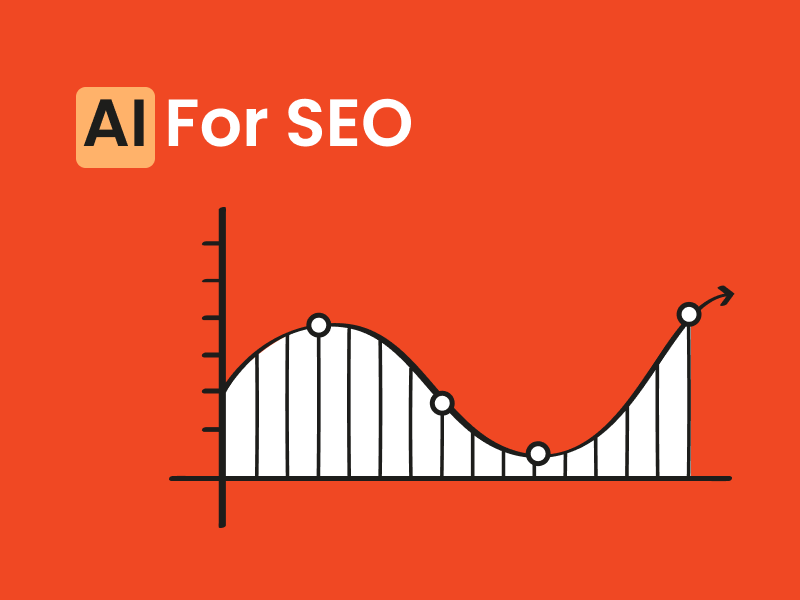Blog Post Examples: How to Write a Blog Guide With 15+ Blog Post Examples
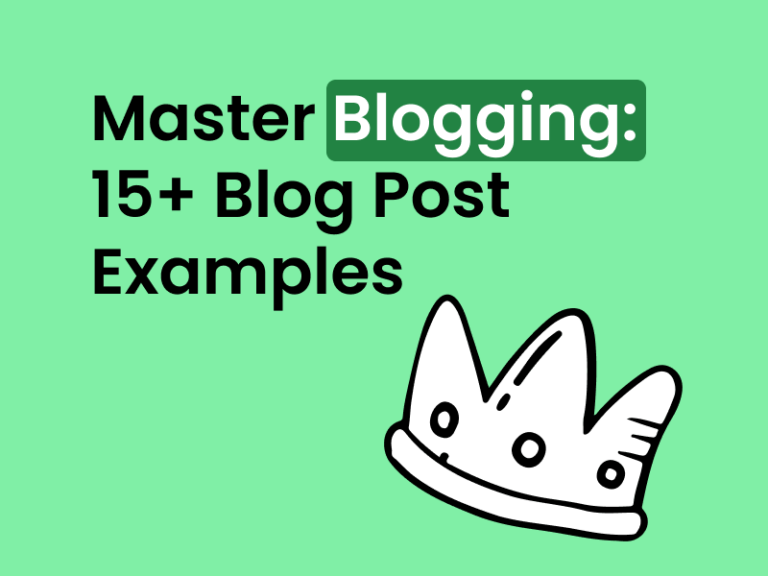
By Melissa Ng | Last Updated 10 November 2023
Introduction
Decoding the Blog Post Phenomenon
Blog posting has evolved rapidly, constantly setting new standards in the digital world. Harnessing the power of money blogging, blog posts serve as a strategic digital tool driving traffic, boosting SEO, and building brand credibility. The power of an exceptional blog copy extends beyond mere written words – they entertain, educate, and engage readers whilst also providing invaluable insights or solutions. With the right query addressed, these posts can significantly impact, especially for those starting their blogging journey with platforms like WordPress.
So, how to write your first blog post, you wonder? Tools like the versatile WordPress editor, Microsoft Office, or Google Docs can assist in crafting your piece. Moreover, understanding your audience, choosing the right format, and offering crystal-clear clarity in every sub-topic is essential. Remember, utilising user intent checking by Googling the keyword is also crucial. This approach assists your blog in transitioning from being a simple writing exercise to a journey of sharing and learning, making it an ingrained part of many people’s everyday life.
Crafting Unique and Impactful Blog Posts in 2024
In the year 2024, blogging continues to be a strategic avenue for communicating your brand’s story, showcasing thought leadership, and building a loyal following. To craft unique and impactful blog posts that truly resonate with your audience, you must focus on a few essential aspects. Primarily, ensure originality, relevancy, and readability of the content you produce, and pay careful attention to the chosen subject matter. Leaving valuable imprints on your reader’s mind often involves harmonising the aesthetic appeal of your company website with the blog’s design, portraying a seamless narrative with your brand’s story.
Personal anecdotes or experiences are a fantastic way to assert your expertise, and by utilising various blog writing tools, you can achieve a conversational tone that fosters connection with your readers. By following a trusty checklist, you can avoid omitting important elements that enhance the overall experience of your blog posts. Consider enlisting the help of an editing checklist and ask a grammar-conscious co-worker to proofread your post.
Supporting visuals and multimedia elements, such as images, tables, infographics, videos, dramatically enhance the impact and readability of your posts, making for a fully immersive experience. Moreover, a consistent domain name that stands unique across various social networks can significantly boost your blog’s visibility and credibility.
A solid blog strategy is incomplete without effective post promotion. Leverage platforms like X (or Twitter), Instagram, Pinterest, TikTok, etc. to ensure your content reaches your targeted audience effectively. Remember to check on your blog’s performance over time, so you can continue to refine your strategy to meet your goals. Never underestimate the power of a finely tuned, well-structured blog post on a strong company website, replete with a catchy domain name. It can work wonders in building and sustaining a loyal following!
Understanding Different Types of Blog Posts
The Power of Listicle Blog Posts
Listicles — articles presented in list form — strike a chord with readers for several reasons. They often contain affiliate links and offer ways to make money blogging, consequently promising a concise reading experience satisfying our need for quick information. The structure of listicles adheres to our cognitive tendencies for processing data.
One exceptional example of a successful listicle is Oberlo’s blog post, “How to Make Money Online: 28 Real Ways to Earn Money Online,” which is well-crafted and integrated with efficient affiliate links. Soaring through Google’s rankings, this post serves as a masterclass in money blogging. The organic traffic it garnered and its low bounce rate further indicates that readers were engaged with the comprehensive roundup of money-making suggestions provided.
Listicles are indeed powerful vehicles for delivering useful, practical, and profitable content. As they continue to evolve in affiliate marketing while adhering to our cognitive tendencies, they’re expected to remain a prominent player in the blogging landscape, not just in 2024 but beyond.

Making the Most of Thought Leadership Posts
Thought leadership posts offer a chance to share expertise on a subject, add unique perspectives on trending topics, and build trust with your audience. These posts, often created in response to a specific industry-related query, extend the reader far beyond generic information, delivering deep insights on focused niche topics. Though these posts might lack in immediate organic traffic due to their novel content, they can counteract this through social shares, orchestrated email marketing strategies, or strategic internal linking.
Neil Patel, an influential digital marketer, exemplifies this approach by regularly posting thought-provoking content, thus strengthening his authority in the marketing domain. Take, for instance, his blog post titled “The Future of SEO: It’s Not What You’re Expecting,” wherein he unveils fresh, non-mainstream perspectives about pivotal SEO trends.
To maximise your thought leadership posts, create a checklist which identifies an intersection between your product, your industry, and your audience’s interests. Using controversial or debatable topics not only sparks readers’ curiosity but also instigates higher engagement levels. Sharing key takeaways from a recent presentation or your perspective on something outside your main role could be another potential approach. The inclusion of support materials like infographics, statistics, and quotes further enhances the value of such posts.

Conquering the Art of Blogging
Creating a Blueprint: How to Formulate a Blog Outline
An outline is critical to any successful blog post as it provides a roadmap for your writing. In tailoring your first blog outline for your recently established domain name, a domain name unique for your company website, it assists in structuring your thoughts and prevents you from going off track while writing. Let’s walk through the process of creating a judicious blog post outline on your blogging platform:
- Topic Decision: Pick a pertinent niche that aligns with your blog’s ambitions and audience.
- Determine Your Goal: What’s your objective? Are you pondering over a subject, supplying advice, or composing a how-to guide? Recognise your intent.
- Research: Delve deeper and check on relevant sources, ensuring your domain name is unique and that nobody else on social networks is using it.
- Headline: Craft a riveting headline that instantly captivates curiosity.
- Break Down the Content: Divide your content into smaller sections using blog post templates — introduction, main body, and conclusion.
- Subheadings: Further dismantle the main body into numerous subtopics using an effective layout, registering subdomains with a website host if necessary, to steer the reader through your blog post smoothly.
- Conclusion: Recap the essential points examined in the blog post.
- Call-to-Action (CTA): Choose a captivating CTA that propels your reader to engage with your post, like spreading the post or opting into your newsletter.
Bear in mind, an outline serves akin to a skeletal framework for your blog post, bestowing structure and continuity, leading to a more robust delivery of your content reflective of your company website.

The Charm of Simplicity: Keeping Language Short and Concise
In the world of blogging, complex sentences and jargon can often deter your readers. Consider employing digital tools such as the WordPress editor, Microsoft Office, Google Docs, Grammarly, or the Hemingway App to simplify your language, just like a seasoned copywriter. With the ability to make your content accessible to a broader audience and to render your paragraphs simple, these tools can create a big difference.
The Hemingway App, for instance, is particularly helpful. It highlights long, complex sentences and common errors, making your writing crisp and compelling. Alternatively, you could opt for using a self-hosted WordPress website on a hosting site such as WP Engine. Remember, your readers crave quick, concise information, so breaking down sentences into digestible snippets using these tools could be a game-changer.
For example, instead of saying, “The product was thoroughly approved of by the customers,” we can revamp it into “The customers loved the product.” This is not only simpler, but it also infuses energy and an active voice into your copywriting. With tools like WordPress, making such changes is a breeze.
In blogging, remember that less is more. Rely on powerful, accessible tools like WordPress to provide precise, relevant information to keep your audience engaged and coming back for more.

Incorporating Research Into Your Blog Content
The Importance of Research in Blogging
Research forms the backbone of every successful blog post. It’s a pivotal part of a prosperous blog strategy, underscoring your prowess and embellishing your articles with credibility. Here are the compelling reasons:
- Research offers an insight into your audience’s preferences and trending niche topics, fostering originality and deterring content duplication.
- It fortifies your viewpoints with sound data and statistics, transforming your blog post into an authoritative resource.
- Studies and references to reputable resources demonstrate your commitment to delivering value and accuracy – a significant factor in carving out a dependable reputation in your niche.
- Research can fire up unique angles and brainstorming ideas for your blog post, emerge as a driving force in your writing toolbox.
- Moreover, it plays a vital role in optimising your blog for search engines by linking to quality-relevant sources potentially propelling your blog post’s ranking. Not forgetting the hidden advantage of embedding affiliate links when your readers click through these links from your website.
Without intensive research, your posts might seem superficial and fail to engage your readers at a deeper level.
How to Effectively Include Research in Your Posts
Effectively incorporating research into your blog post is not just about stating facts and figures. It’s about strategically interweaving this data into your narrative, seamlessly, with the use of blog post templates. Blog posts can be an irritating and tedious process regarding formatting, but by using these templates, you’ll save time and effort. Here’s how to do it:
- Make Stats Relevant: If including statistics, always explain why they matter. This relevance adds weight to your post and keeps the narrative grounded.
- Cite Sources: Always give credit to your sources. This builds credibility, and it’s also an excellent opportunity to build backlinks for SEO and include affiliate links — a tried-and-true way to promote your blog posts.
- Use Graphics or Charts: Complex data can often be better expressed visually. Use infographics, charts, or diagrams to convey your research.
- Create a Flow: Insert research organically within your text instead of randomly placing facts and figures. As part of your content creation process, it would be beneficial to brainstorm audience attributes from scratch. The goal is to support your points, not overshadow, by weaving hard data into the narrative fabric of your piece.
By effectively incorporating research, you’re enhancing your content’s authority, improving its SEO performance, and providing value to your readers. Remember, while numbers may not tell the whole story, they help in validating your points. Abiding by these guidelines can make your first blog posts a less agitating, time-consuming experience.
The Impact of a Strong Opening Sentence
Why an Engaging First Sentence Matters
The first sentence of your blog post, also known as the hook, plays a crucial role in drawing in your audience. The artful manipulation of blog copy, complemented by effective formatting, can make the difference between a quick exit and sustained readership. Just as a compelling title encourages clicks, an engaging, well formatted first line determines whether your reader will stick around and continue reading.
Your opening statement can either instantly capture user interest through interesting typography and layout, leading them to eagerly anticipate what comes next, or it can succinctly state the value proposition, giving the reader a clear, visually appealing reason to read further. This highly resonates with what William Zinsser believed, “The most important sentence in any article is the first one.”
Before you start crafting your opening line or working on its formatting, consider the user intent as this can guide your writing process. This systematic approach, bolstered by understanding your reader’s intent and adding suitable formatting, can lead to consistent blog post success.
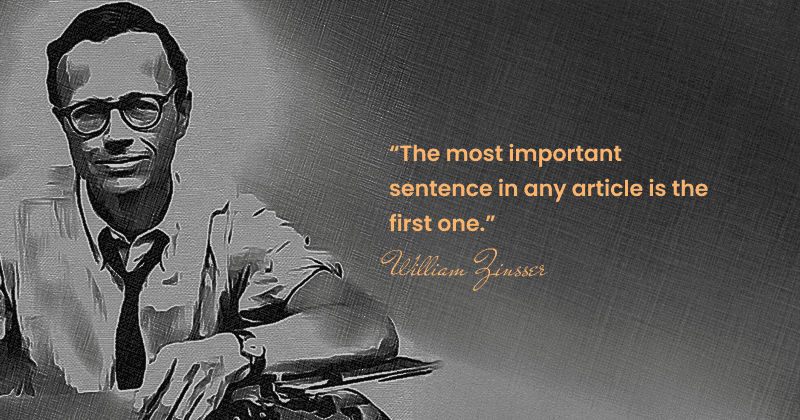
Techniques for Crafting a Compelling Opening Sentence
Crafting an engaging first line is crucial because if it doesn’t hook your reader, your post won’t have the impact you’re aiming for. Here’s where blog writing tools like the WordPress editor can revolutionise your writing process by providing the essential guidance and ease. Here are the four techniques to start your blog post with a bang:
- Start with a Bold Statement: A striking, bold statement can intrigue your reader and make them curious to know more. For instance, “Content Marketing is dead.” WordPress’s inline editing tools can help fine-tune this attention-grabbing approach.
- Open with a Question: This can make your reader think and spark an interest in digging deeper. Try using blogging tools on a self-hosted WordPress website on a hosting site such as WP Engine for myriad of ideas and guidance. E.g., “Have you ever wondered why Google ranks some web pages higher than others?”
- Share an Interesting Statistic or Fact: A little-known fact or a compelling statistic can amplify the value your blog post provides. Example: “Did you know that 70% of businesses lack a content marketing strategy?”
- Tell a Story: Starting with a gripping narrative can draw readers in and help them engage emotionally with your blog post.
Writing Winning Blog Posts
Mastering SEO for Maximum Reach
As 2024 sets in, SEO continues to be a powerful player in propelling your blog post’s visibility on search engines. Addressing user queries and capitalising on search intent remains fundamental in SEO according to growth marketer, Cody Arsenault. Snaking in the data-rich world of SEO can be a daunting task. Here’s how you can master techniques:
- Keyword Research: Use tools like Google Keyword Planner or Ubersuggest to identify relevant, high-volume keywords aligning with your blog post or user query. Don’t just sprinkle these keywords; strategically integrate these words into your title, header tags, meta descriptions, and throughout the content while paying particular attention to search intent.
- Optimise Images: Inject essential keywords in alt text of images, heightening the chance of your photos being discovered on image searches as well as improving your blog’s on-page search engine optimisation (SEO).
- Structured Data: Deploy Schema Markup to provide search engines with more comprehensive information about your content, enhancing your visibility in SERPs, and addressing user queries more effectively.
- Internal and External Links: Integrate relevant internal and external links throughout the blog. Incorporating affiliate links can not only strengthen your blog’s authority but also provide a steady income source when users click through these links.
- Meta Description: Forge a compelling meta description using your primary keyword. This practice is not just crucial for SEO but also acts as a lure attracting user clicks.
- Mobile Optimisation: In this predominant mobile era, ensure your blog is thumb-friendly.
Properly used, these SEO techniques will make your blog post more appealing to both the search engine algorithms and users thereby driving more traffic to your blog post. If you’re up against high-authority competition, you’ll be better equipped to offer unique content that addresses less-explored user queries.

Incorporating Media with Purpose: Tips on Using Visuals and Infographics
Practicing strategic placement of multimedia elements can enhance the readability of your blog posts. By implementing a colour palette that ties together with your company website, you can increase the overall aesthetic of your content, making it more appealing to your readers. Here are some essential tips for effectively incorporating media with purpose:
- Use Relevant Images: Choose images that are pertinent not only to the content, but ones that also harmonise with your company website’s theme. They provide visual breaks, support your points, and keep the readers captivated.
- Infographics: These graphical illustrations, especially when they align with the style of your company website, are great for summarising complex topics engagingly. Infographics are more likely to be shared, expanding your reach. For instance, suppose you’re detailing the benefits of remote work. In that case, affirm your arguments with a captivating and easy-to-digest infographic.
- Add Alt Text to Images: Including alt text ensures that search engines, including those crawling your company website, comprehend your image content. This technique bolsters your SEO and enhances accessibility for users with visual impairments.
- Videos: Incorporate pertinent videos where necessary. Remember, some points resonate more easily in a visual format. For example, a tutorial blog post would significantly benefit from a step-by-step video guide hosted on a subdomain of your company website. Platforms like YouTube offer wide-ranging demonstrations of concepts that can aid your readers in understanding better.
- Charts and Graphs: These are idyllic for presenting data. Instead of just explicating statistics or trends in words, use a graph or chart that could also become a crucial visual element on your company website.
With the right media, your blog post can transform into a dazzling tapestry of words and visuals rhythmic with your company website’s tune. Apart from being engaging, it helps readers recollect the information long after they’ve left your site. For instance, the blog “Young House Love” displays effective media usage. Be on the lookout for an update post for their recent demo.
With these tips, you’re not just enhancing the engaging aspect of your content, but also elevating your SEO rankings, owing to the integration of company website-related keywords and usage of alt text for images. Keep your readers anticipating your next update post; remember, it’s all about retaining their interest and ensuring they return to your company website for more!
Looking for some more inspiration, check out our blog post: WordPress Blog Examples: 30 Most Beautiful and Popular WordPress Blogs in 2023
Breathtaking Titles: A Guide for Generating Engaging Titles
The title is the first thing that catches a reader’s eye and has the power to make or break their decision to click on your blog post. Similarly, a blog’s domain name serves as a crucial identifier, setting the first impression. Hence, the domain name selection process can be as important as crafting the blog content itself. As with your content, your domain name also needs to be top-notch and distinctive, luring readers in. Here are a few tips for writing a compelling blog post title and selecting a resonating domain name:
- Incorporate Keywords: Ensuring your title includes relevant keywords not only aids SEO but also gives your readers an idea of what the post is about. In the case of your domain name, integrating keywords that complement your niche can work wonders in defining your blog’s identity and aligning it closely with the audience’s searches.
- Make It Eye-Catching: Use power words, numbers, or pose a question to create a title that stands out. Consider the difference between “Tips for Baking a Cake” and “10 Foolproof Secrets to Bake the Perfect Cake!” A captivating domain name, following the same principle, can help to attract a wider audience.
- Keep It Accurate: Your title and domain name need to truly represent your content and brand respectively. Misrepresenting information in the hope of garnering clicks will harm your reputation and can lower your SEO rankings.
- Keep It Short: Your title should ideally be between 60 to 70 characters long to display correctly on search result pages. A concise domain name, mirroring this concept, favours memorability and boosts the ease of sharing.
- Test Your Titles and Domain Names: Use tools like CoSchedule’s Headline Analyzer or perform A/B testing to help select the most impactful title and domain name. It’s also wise to verify that your chosen domain name isn’t already in use elsewhere, especially on social networks.
Remember, the perfect blog post title and domain name strike a balance between attractiveness, informativeness, and SEO-friendliness. Your domain name and logo should serve as a powerful reminder of who’s publishing the content. Before deciding on a domain name and proceeding to purchase, customise its appearance to reflect your blog’s theme as this helps to build a stronger brand identity.
Crafting Riveting Conclusions
The conclusion of your blog post is one of the most vital sections that can provide a sense of closure. Mastering the art of crafting this section, augmented with attractive discounts or free trials, can significantly enhance your blog post’s effectiveness, contributing to an increase in brand awareness and, ultimately, conversions. Let’s dive into how:
- Sum Up: Your conclusion should neatly wrap up the main points discussed in the blog, thus reinforcing your position as a thought leader in your industry.
- Call to Action: Encourage your readers to take action. Whether it’s posting a comment, sharing the blog, taking advantage of a unique discount offer, or checking out a related post you’ve written. This promotes reader interaction leading to increased brand awareness and credibility.
- Engage: Ask a question or request feedback to promote active engagement.
Example: “We hope these tips help you avoid common indoor gardening mistakes. Which tip did you find the most helpful? Share this post with other indoor gardening enthusiasts in your circle. And remember, the key to a green thumb is perseverance and continual learning.” Remember, well-crafted conclusions can directly impact conversions by guiding the reader to the next desired action, like availing a discount.
Fine-Tuning Your Blog Post
The Importance of Editing in Achieving Blogging Success
Never underestimate the power of effective editing. Navigating your first blog posts doesn’t have to be an agitating, time-consuming experience if you understand the value of meticulous editing, perhaps utilising a handy checklist. Even the most seasoned writers can draft blog copy fraught with mistakes or clunky sentences. Like refining a dish to perfection, editing — with the aid of an editing checklist or two — enhances your blog post’s readability and credibility, ensuring your ideas are crisply conveyed.
Editing isn’t merely limited to checking for grammatical errors, spelling, and punctuations. It dives deep into the structural aspects of your blog copy, the post’s overall coherence. By engaging in a comprehensive review of your blog post from your reader’s perspective — using a checklist for consistent steps — you ensure the information resonates as intended in the copy. This is where working with a professional editor or leveraging tools, emerges as a critical approach to consistently grow successful sites, reflecting the credibility of a well-edited, crisp, error-free blog post that enhances your blog’s charm, readability, and reputation.
Consider using editing tools like Grammarly or Hemingway App as they act like copy/paste templates helping you spot errors and enhance your writing quality. Perhaps use of a fail-safe editing checklist would serve well here too.
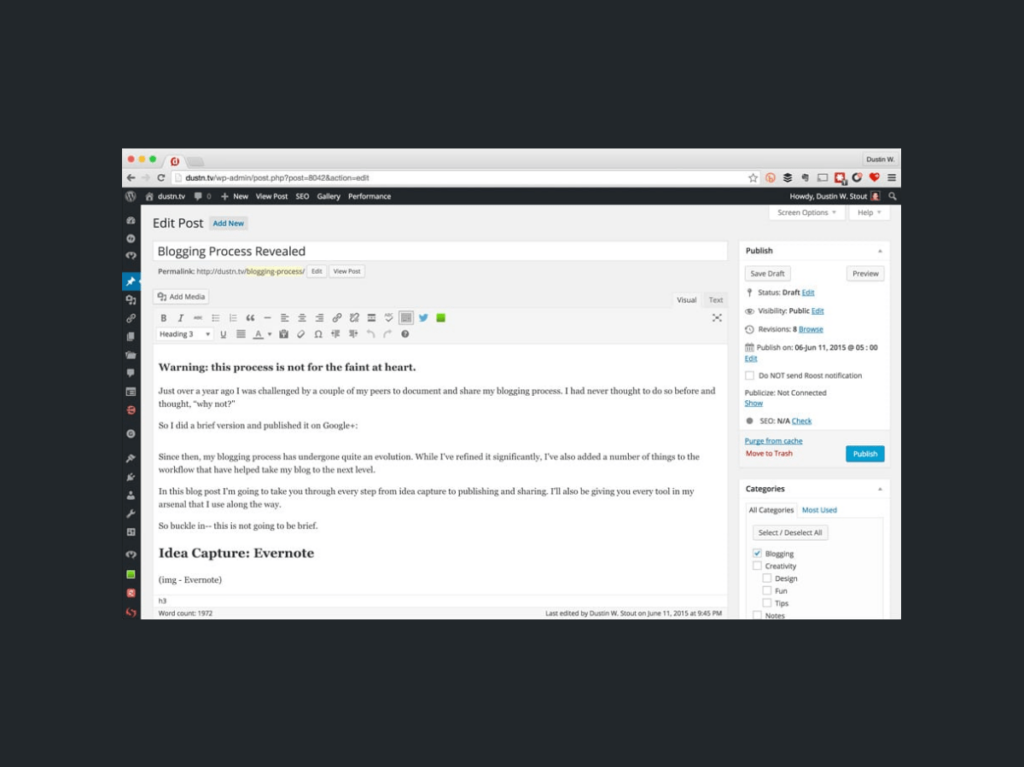
Proofreading Strategies that Work Like Magic
While editing focuses on content structure and clarity, proofreading zeroes in on surface errors such as grammar, punctuation, and spelling. Even the smallest mistake can distract readers, potentially affecting your blog’s credibility and impact. Here are some proofreading strategies that work wonders with the aid of an editing checklist:
- Take a Break: After editing, make it a point on your checklist to allow yourself some time away from the content before proofreading. It helps refresh your perspective and increases the likelihood of spotting errors.
- Read Out Loud: This simple trick helps you notice awkward phrasing or word repetition that you might overlook during silent reading.
- Use Tools: Online tools like Grammarly or ProWritingAid can spot errors that might slip through human review. Include them in your checklist.
- Print it out: Sometimes, reading your content in a different format can help you notice errors you might have missed on the screen. Put this on your checklist as well.
- Ask Someone Else: A fresh pair of eyes can spot things the writer overlooks. Make this a part of your checklist and consider asking a grammar-conscious co-worker to copy edit and proofread your post.
Remember, proofreading as a step is not optional; it’s critical. It’s the polishing touch that your content needs to make it shine in the world of blogging.
Optimisation Essentials
On-Page SEO Tactics for Blogger Success
On-page SEO is a crucial component in ensuring your blog post ranks well in search engine result pages (SERPs) and reaches a wider audience. Mastering search engine optimisation – not unlike Cody Arsenault, a renowned growth marketer – can help you optimise essential elements of your post, including affiliate links. This allows search engines to understand, index, and disseminate your content more effectively among interested readers.
Here are some top-tier on-page SEO tactics that could turbocharge your blogging success:
- Meta Descriptions: Craft an enticing description using your primary keyword. While not a direct ranking factor, a remarkable meta description can exponentially increase click-through rates for both your site and any affiliate links included, thereby enhancing your visibility across search engines.
- Title and Headers: Weaving in your target keywords and affiliate links into your titles and headers, while ensuring they blend in organically, is crucial. Your headings should prioritise readability and clickability over keyword cramming.
- Anchor Text: In the creation of your post’s links, especially affiliate links, use descriptive anchor texts. Giving readers and search engines a sneak peek of the linked page’s content greatly improves your on-page search engine optimisation.
- Multimedia: Enrich your images and videos with alt text and descriptive names. This not only boosts your blog’s SEO but also the user experience, making it engaging and interactive.
- URLs: Develop simple, self-explanatory URLs that contain your keyword. For instance, ‘how-to-write-a-blog-post’ is much more effective than ‘post123’.
By incorporating these sought-after tactics, you can elevate your blog post’s SEO performance and its reach to the target demographic.

Making CTAs (Calls to Action) Effective: Best Practices and Examples
A Call to Action (CTA) is a critical part of any blog post as it motivates your readers to take an action, such as subscribing to a newsletter, downloading an ebook, or sharing the post on social media. Effective CTAs are powerful tools that can significantly improve blog post engagement, meet your content marketing goals, and importantly, boost conversions while also enticing readers with promising discounts or opportunities to try something for free. Here are some of the best practices and illustrative examples:
- Be Direct: When it comes to conversions, frankness counts. Your CTA should give clear instructions. If you desire readers to sign up for a newsletter and possibly gain a discount, say “Sign up for our newsletter and get a discount”.
- Create Urgency: Engage your readers’ fear of missing out. Encourage immediate action with phrases like “Limited discount offer” or “Sign up now and grab your discount”.
- Use Action Words: Starting your CTAs with active verbs like “Learn more”, “Download now”, or “Buy today with a special discount” can invigorate users’ actions, hence favouring conversions.
- Design Matters: A visually captivating CTA can increase conversions. Design yours to stand out — use a contrasting color, choose a larger font, or experiment with a unique shape.
- Placement: Intelligent placement of your CTA, whether right after an important point, in the middle of your post, or at the end, can influence a substantial growth in conversions.
Remember, the best CTAs are persuasive, provide value, create opportunities for discounts, are easy to act upon, and above all, facilitate better conversions.
Real-life Inspirations: Successful Blog Post Examples
Inspiration from Popular Personal Blog Examples
Drawing inspiration from the best always helps. For instance, we can look at food blog examples, business blogs, and even WordPress-based blogs to widen our perspective. Here are a couple of examples of popular personal blogs that truly stand out in the digital landscape:
Gary Vaynerchuk’s Blog: This WordPress-powered blog, a prime instance of successful business blogs, skillfully uses the user-friendly interface of WordPress to balance thought-leadership and promotional content seamlessly. Gary’s engaging and informative posts have accumulated a massive following that eagerly ingests his rich knowledge and the products he promotes.
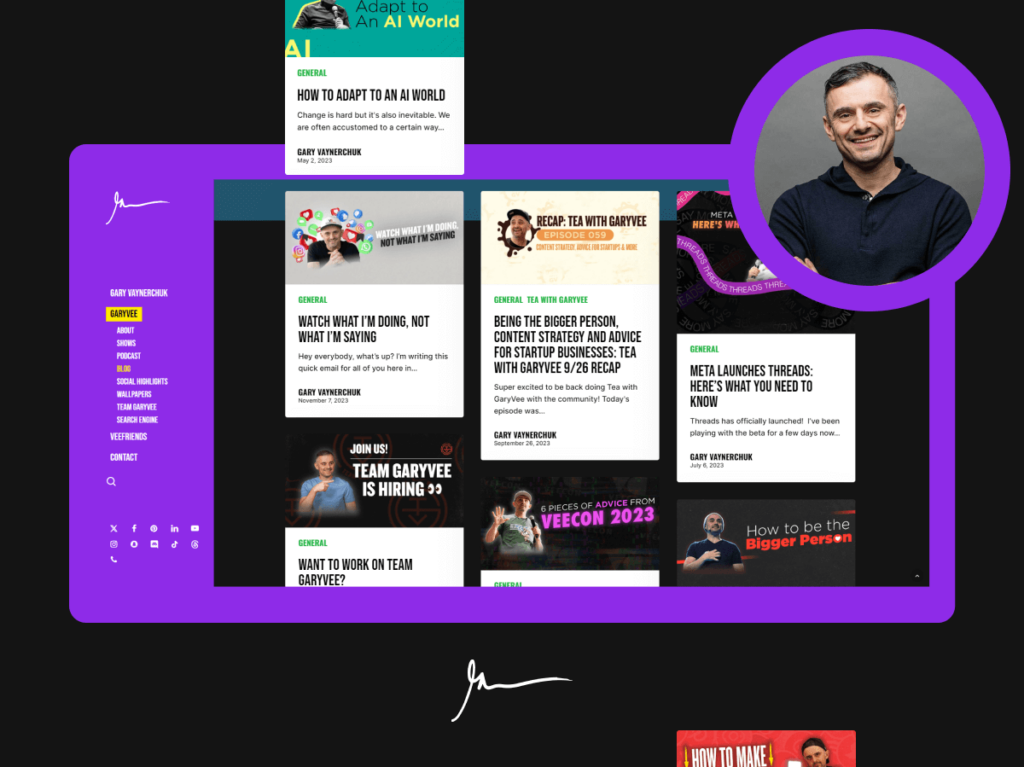
Seth Godin’s Blog: Also a good example among business blogs, Seth Godin, a renowned marketing guru, operates a minimalistic blog without a heavy use of images or videos. His short, insightful posts, much like posts in WordPress and food blog examples, exude authority and provide substantial value, proving that compelling content is enough to keep readers hooked.
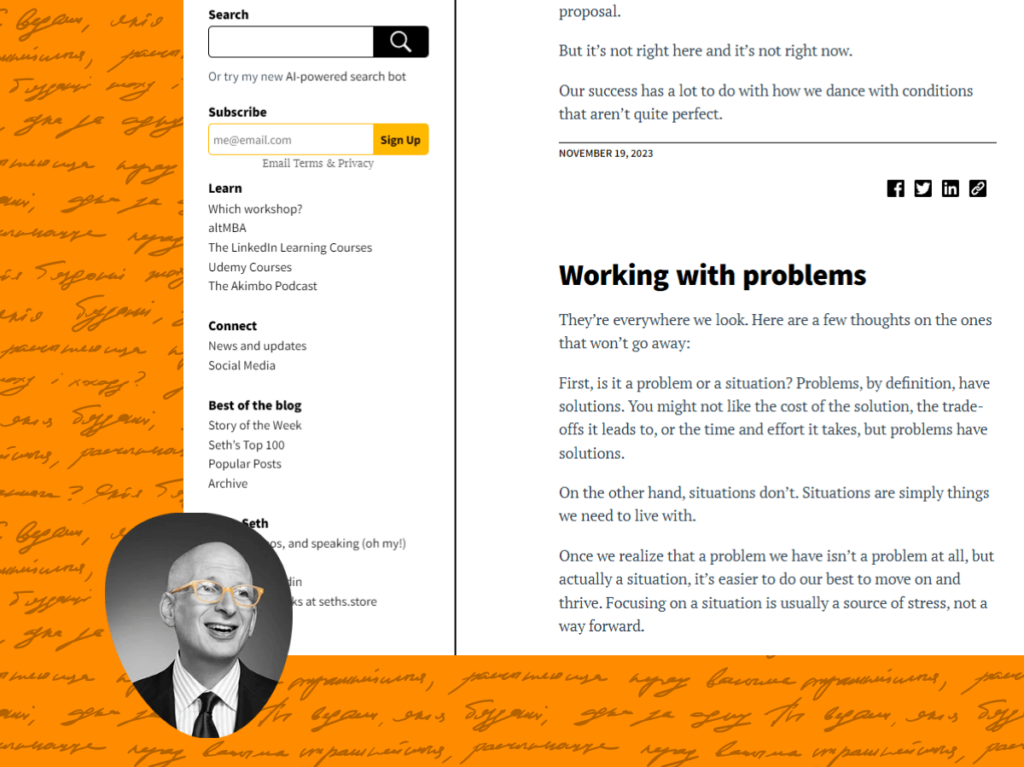
Gretchen Rubin’s Blog: As the author of “The Happiness Project,” Gretchen Rubin’s blog dives into habits, happiness, and human nature. It’s a resource-rich site where she shares her experiments and experiences in the pursuit of happiness and habit formation.
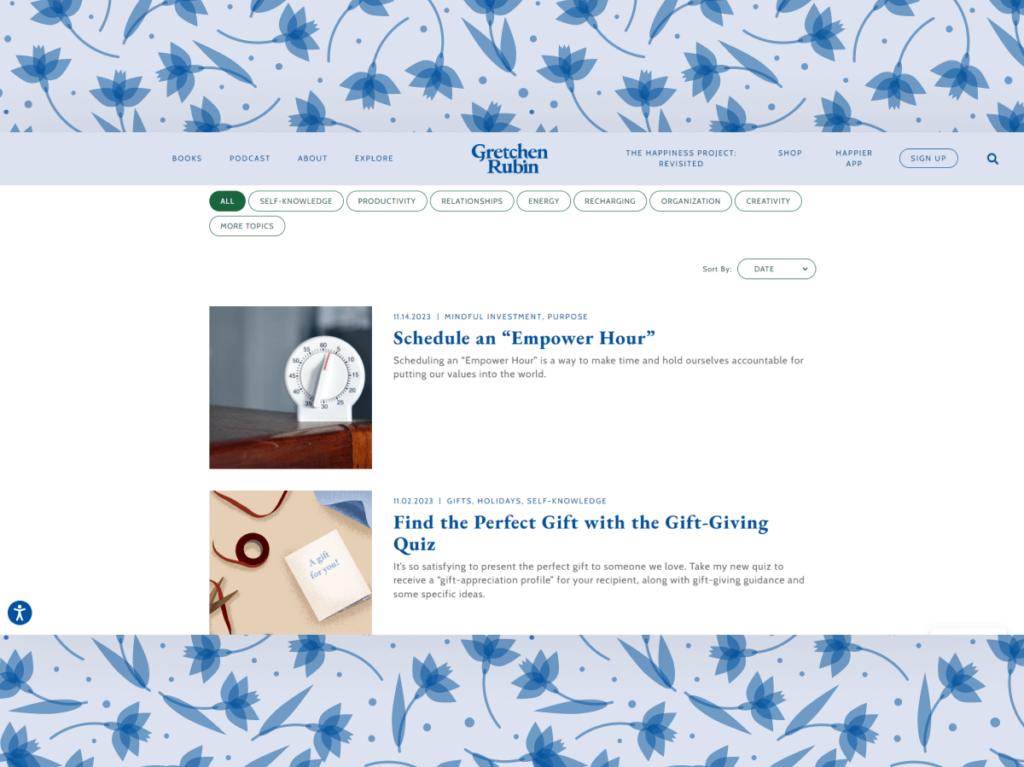
Mark Manson’s Blog: Mark’s blog offers a mix of personal development with a blunt tone of truth. His deep dives into human behavior, relationships, and psychology offer readers a no-nonsense approach to self-improvement and have garnered a significant following.
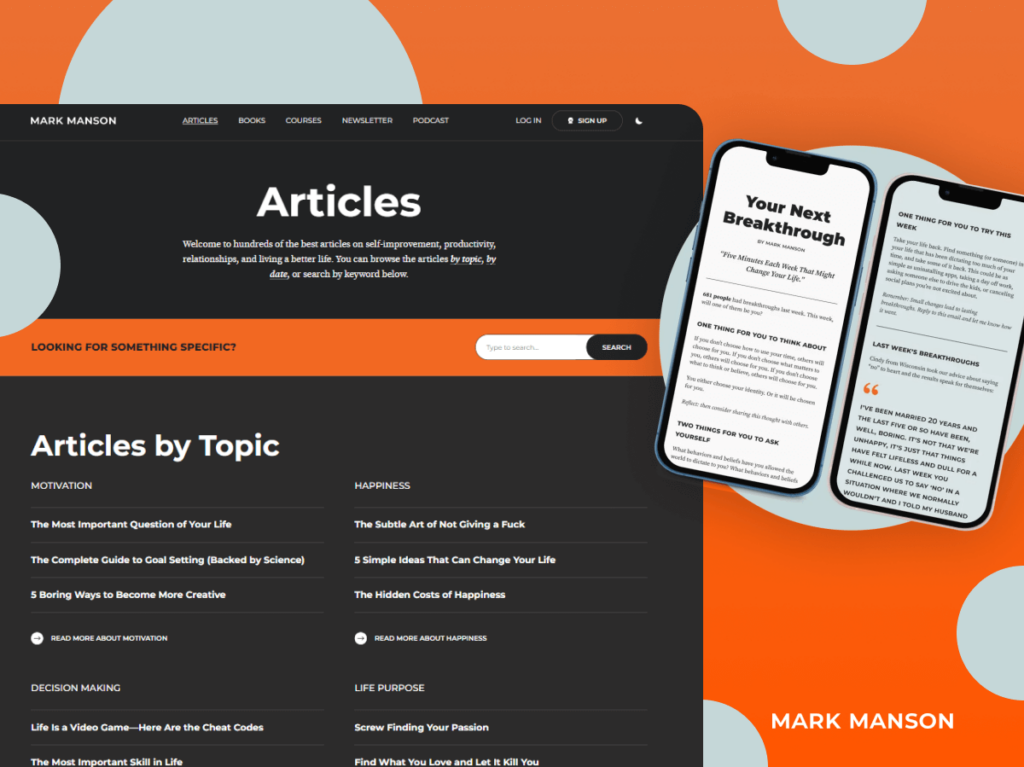
James Clear’s Blog: James Clear writes about habits and performance improvement, providing practical strategies grounded in scientific research. His blog has become immensely popular, especially among those looking to make meaningful, incremental changes in their lives.
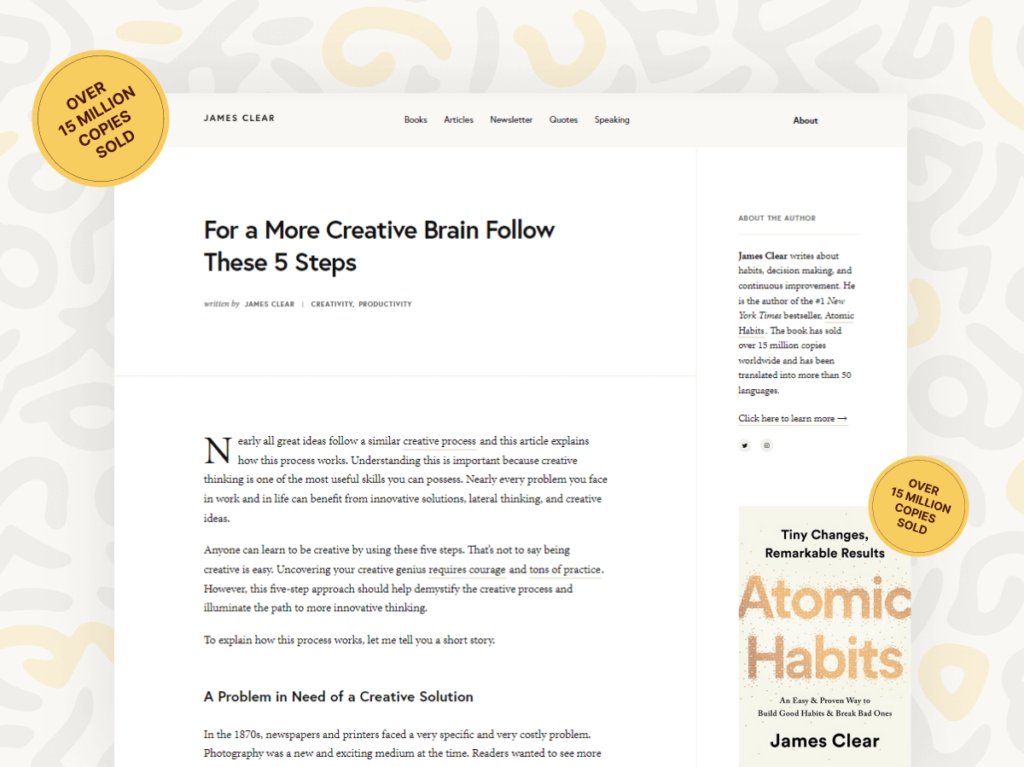
The Financial Diet: Chelsea Fagan’s blog discusses personal finance in a relatable way, particularly targeting young women. It covers a range of topics from managing money to personal and professional development, all aimed at making financial literacy more approachable.

These examples illustrate that by developing your unique voice, focusing on providing value, consistent posting, and leveraging platforms like WordPress – much like in the successful food blog examples and business blogs you read, you can carve your niche in the blogosphere.
Learning From Successful Lifestyle Blogs
Lifestyle blogs are a great source of inspiration because of their broad appeal and relatable content. Amongst them, a popular subset is the interior design blog, offering readers discounted or even free options for aesthetic and functional spaces. Let’s look at successful lifestyle and interior design blogs providing these benefits:
Goop: Gwyneth Paltrow’s wellness, lifestyle, and budding interior design blog, Goop, stands out for its high-quality, curated articles. The blog occasionally offers discount options on travel, style, health, wellness, and the emerging trend of stunning living spaces.
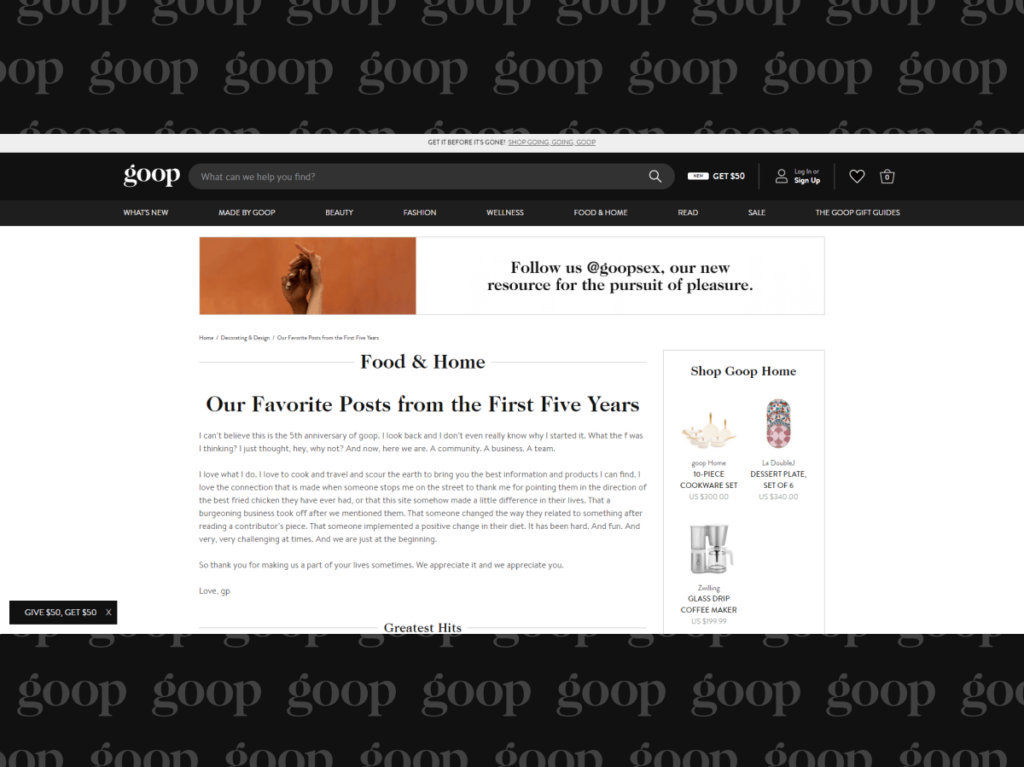
A Cup of Jo: Joanna Goddard’s blog, A Cup of Jo, not only covers a wide spectrum of topics, including style, culture, motherhood, travel, and food but also includes a dedicated section to cost-effective home interiors. The blog thrives on Joanna’s relatable style of writing and her ability to reflect authenticity that resonates strongly with her readers.

The Blonde Salad: Chiara Ferragni’s fashion and lifestyle blog, The Blonde Salad, successfully blends her personal stories with fashion advice, lifestyle tips, and has recently branched into the sphere of discount interior design. Her segments on tasteful, budget-friendly home designs prove quite insightful for those seeking home decor inspiration.

Simply Luxurious Life: Shannon Ables’s blog is dedicated to the art of living well. It provides readers with content on personal style, fine living, and simple yet luxurious living tips. The blog often delves into home organisation and elegant living spaces, offering advice on how to create a luxurious home environment without breaking the bank.

Wellness Mama: Katie Wells runs this comprehensive resource for healthy living, with a focus on natural wellness and home remedies. The blog also extends into natural beauty tips, home cleaning hacks, and nutritious recipes. It’s a hub for those who aspire to a healthy, toxin-free home environment.
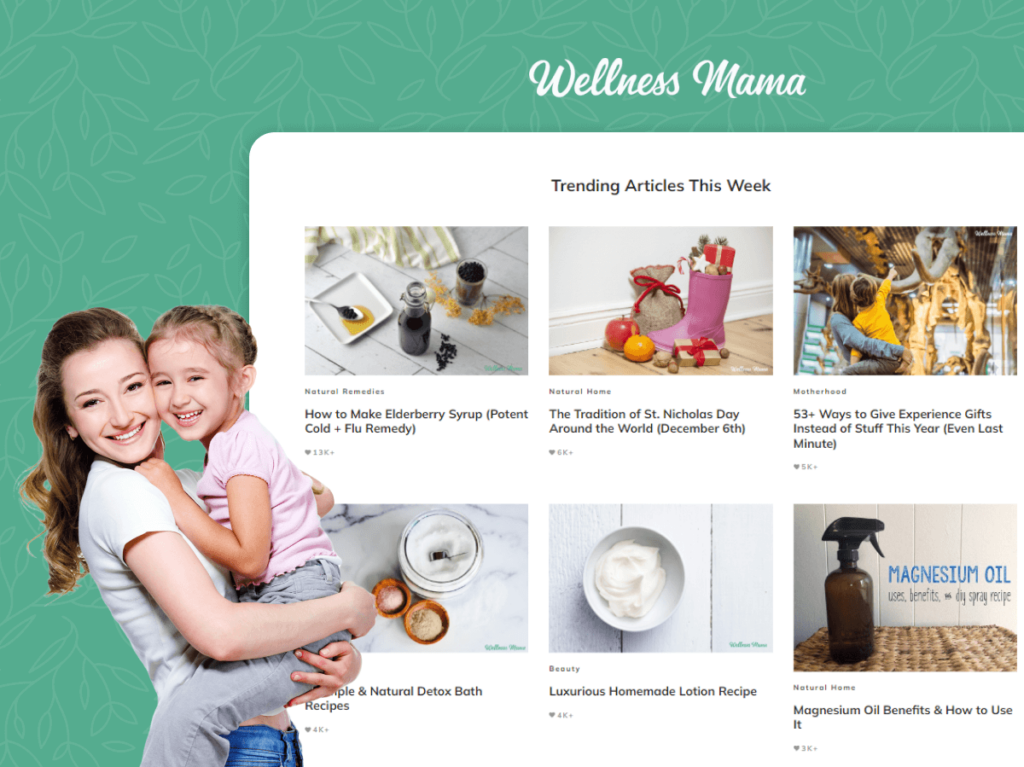
The Everygirl: Co-founders Alaina Kaczmarski and Danielle Moss have created a space that empowers career-oriented women to lead a balanced and stylish life. The blog features diverse content, including accessible interior design tips, personal development, career advice, and wellness. It’s especially appealing for those looking to infuse their everyday life with practical yet chic elements, from their wardrobe choices to their living spaces.

By keenly analysing these blogs, particularly their successful integration of discount options in the interior design niche, one can ascertain that the winning formula lies in consistently delivering enjoyable, high-quality content that’s true to your brand’s ethos — all while forming a personal connection with your audience and offering enticing discounts to convert readers into customers.
Gleaning Insights from Top Travel Blogs
Successful travel blogs showcase a beautiful blend of visually appealing content with engaging narratives. Many of these manage this blend by smart use of blogging tools like WordPress editor. Here are some learnings from top travel blogs:
PS I’m On My Way: Trisha, a digital nomad, shares her travel stories and practical information, such as visa process and travel budgets, via her self-hosted WordPress website. Her authentic storytelling combined with useful advice illustrates the perfect blend that makes a travel blog successful.

Hand Luggage Only: UK duo Yaya and Lloyd’s WordPress-powered travel blog stands out because of its breathtaking photography, engaging narratives, and unique travel tips. Their personal anecdotes and eye-catching visuals, all configured on their WordPress site, make the blog a hit among travel enthusiasts.
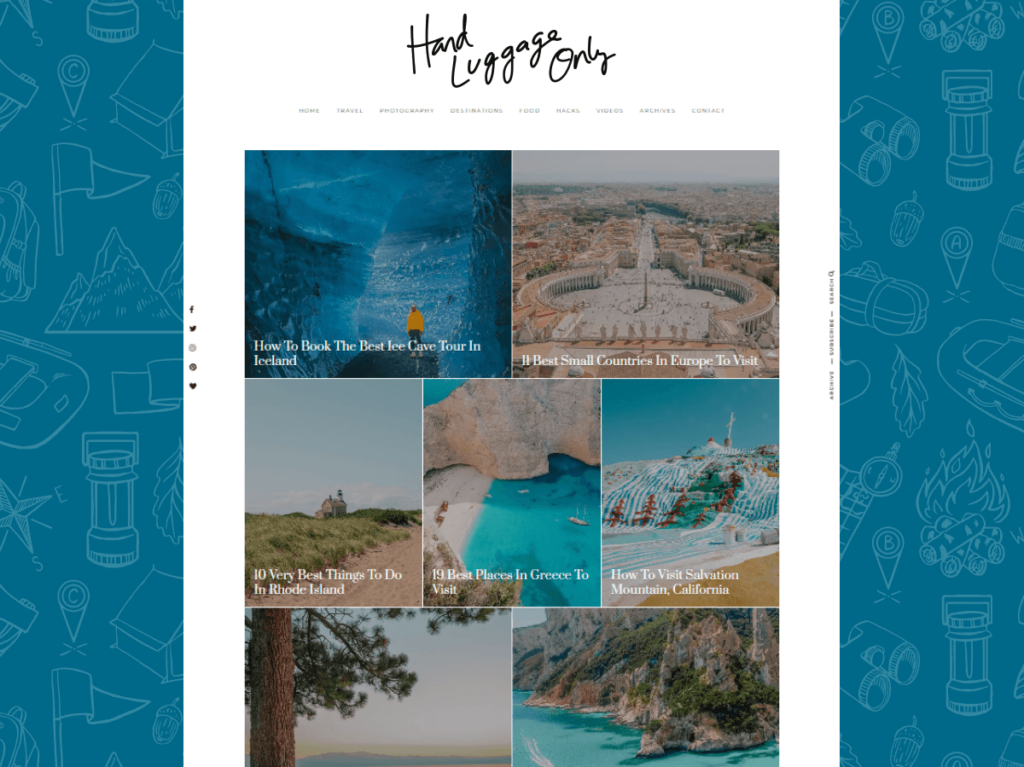
Helen in Wonderlust: Helen, using the WordPress platform, offers a focused approach by offering travel advice concentrated on Africa. This shows that having a clear niche in travel blogging can help you stand out.

Nomadic Matt: Matt Kepnes runs one of the most popular travel blogs where he shares detailed budget travel guides, tips for saving money, and comprehensive resources for traveling around the globe. His WordPress blog has become a go-to source for backpackers and budget travelers looking for practical advice to travel more while spending less.

The Points Guy: Brian Kelly and his team of contributors have turned The Points Guy into a crucial resource for those looking to maximize their travel rewards. Covering everything from airline news to credit card points strategy, this blog is perfect for savvy travelers who want to leverage rewards programs to access travel opportunities.

Legal Nomads: Jodi Ettenberg’s blog blends travel with storytelling, focusing on food and the stories behind it as a way to understand the world. Jodi uses her platform to share not only her own tales but also the cultural significance of cuisine from around the world, providing a unique lens through which her readers can explore new destinations.
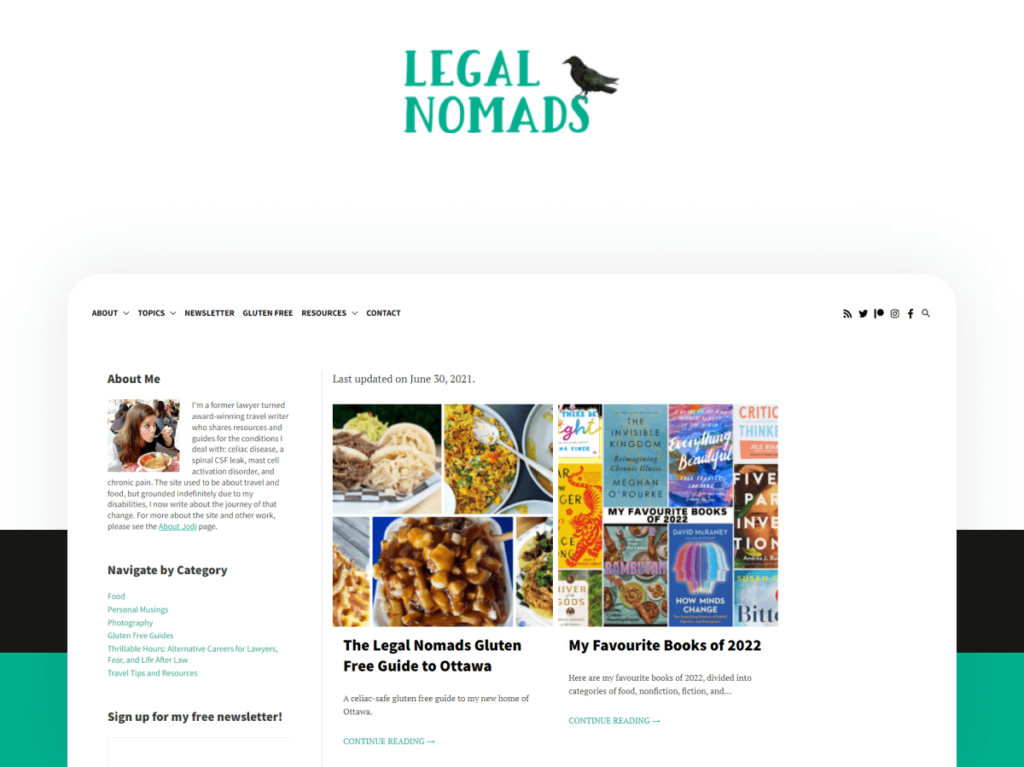
These blogs highlight that authenticity, visual appeal, and personal stories are vital when it comes to crafting a successful travel blog.
Looking for some more blog ideas? Head over to our article: WordPress Blog Examples: 30 Most Beautiful and Popular WordPress Blogs in 2023.
FAQ
How long should a blog post be?
The optimal length of a blog post depends on several factors, including the subject, your audience, and your SEO goals. However, research conducted by Backlinko indicates that posts around 1447 words [1], testing positively for SEO performance. Nevertheless, creating in-depth, authoritative posts between 3000-10,000 words also do well, particularly for pillar posts or definitive guides.
The key is to focus on delivering value and addressing your audience’s needs, irrespective of the length. Integral to crafting engaging blog content is also thoughtful formatting. Consider using templates or apps to streamline your formatting process. This not only saves time but aids in maintaining the reader’s attention. Remember, quality overrides quantity any day — both in content and formatting.

How often should I post blogs?
The frequency of blog posts varies depending on factors such as your niche, resources, and audience engagement. However, research shows that companies that blog 16 or more times per month get almost 3.5 times more traffic than those that blog 4 times or less [2]. Amid this higher frequency, managing blog formatting can sometimes be challenging, but you can always streamline it using suitable templates or tools. For a fledgling business blog, aim to post at least once a week and ramp up frequency as you grow. But remember, formatting should be consistent and quality should never be compromised for quantity.
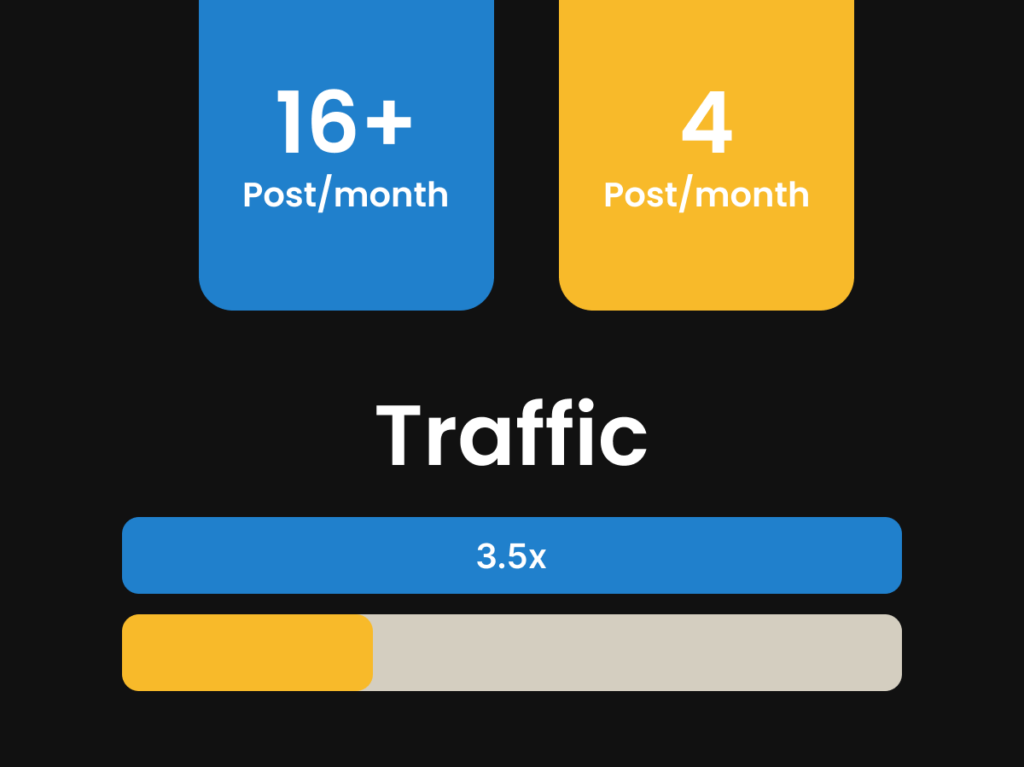
What are some catchy title examples for my next blog post?
Creating catchy blog titles is an art in itself. They not only need to evoke curiosity and indicate the blog post content, but they also serve as an integral part of your blog post topic strategy. Incorporating an element of a discount or an enticing free offer can help to convert readers into potential customers. Here are a few captivating and discount-oriented examples:
- “5 Secrets About [Topic] That Experts Won’t Tell You”
- “The Ultimate Guide to Conquering [Topic] at a Discount”
- “10 [Topic] Hacks for the Time-Starved Individual: Discount Edition”
- “[Topic]: Myths Debunked! Now at a Discount”
- “[Topic]: Quick Fixes for Common Challenges at a Discount”
- “Unlock the Power of [Topic] – Now With Exciting Discounts “
Remember, the title is more than just a heading; it’s an invitation to engage with your content. So, make it irresistible! And if you’re still unsure about how to name your blog post effectively, consider exploring tools such as a blog name generator. These can be immensely helpful in creating impactful and discount-enticing titles.
Sources
[1] Backlinko: https://backlinko.com/search-engine-ranking
[2] HubSpot: https://blog.hubspot.com/marketing/blogging-increases-traffic
Submit An App
Seen a cool app you think we should review? Submit your recommendation using our form.
